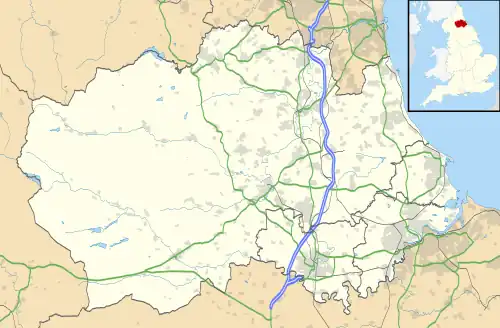Knitsley
Knitsley is a hamlet in and former civil parish, now in the parish of Healeyfield, in the County Durham district, in the ceremonial county of Durham, England. It is situated a short distance to the south of the town of Consett. In 1931 the parish had a population of 2276.[1]
| Knitsley | |
|---|---|
 | |
 Knitsley Location within County Durham | |
| Civil parish | |
| Unitary authority | |
| Ceremonial county | |
| Region | |
| Country | England |
| Sovereign state | United Kingdom |
The name derives from Old English and means the meadow where knights were//the knight's field/knight's clearing.[2][3][4]
Knitsley is mentioned in a charter of c. 1250 in which Adam of Knychley held lands near Iveston. Further charters of 1280 list Hugh of Cnicheley and William of Knicheley, the latter a witness for John de Chilton of Healyfield.[5][6] In Bishop Hatfield's Survey (1381), Robert of Kellawe held the vill of Knycheley.[7] The lands passed through various holders including, the Surtees, Eure and Claxton families, the latter holding the manor until the 1620s. In the 1800s the land was owned by the earls of Coventry until it was sold to tenants in 1920.[8]
With the Inclosure Act of 1773[9] the common lands of Knitsley were enclosed and sold off.[10][11]
The landscape gardener and arboriculturalist, Thomas White (1736-1811),[12] took advantage of the enclosure and sale of land purchasing over 200 acres. He planted a wide variety of trees, landscaped the gardens and built a house, Woodlands Hall, in 1779. With the death of Thomas White the younger in 1831 the house and estate passed through numerous families including John Richardson (died 1871) of Shotley Park. The estate was then bought by William Brewis Van Haansbergen, who lived there until his death in 1921.[13][14][15]
There was a Primitive Methodist meeting house (listed as Salem Chapel on the 1857 Ordnance Survey map) established in 1842.[16] It seems to have been demolished in the 1950s.
There is a pub (some way outside of the village) called The Old Mill.[17] A telephone box once existed at the end of Hownsgill drive but this was removed many years ago due to lack of use.
The railway station serving the North Eastern Railway was opened in 1862. It existed until 1964 when cutbacks in the railway system dramatically reduced rail services in Britain. The old railway line is now part of the Lanchester Valley Railway Path. [18]
Civil parish
Knitsley was formerly in Conside-cum-Knitsley township, in the parish of Lanchester,[19] from 1894 Knitsley was a civil parish in its own right, on 1 April 1937 the parish was abolished and merged with Healeyfield and Consett.[20]
References
- "Population statistics Knitsley CP through time". A Vision of Britain through Time. Retrieved 7 August 2023.
- Ekwall, Eilert (1960). The concise Oxford dictionary of English place-names (4 ed.). Oxford: Clarendon Press. p. 282. ISBN 0-19-869103-3.
- Mawer, Allen (1920). The place-names of Northumberland and Durham. p. 130.
- Jackson, Charles E. (1916). The place-names of Durham. p. 73.
- Fawcett, J.W. (1925). "The Township of Knitsley, Co. Durham". Archaeologia Aeliana. Ser. 4, vol. 1: 37–38.
- Surtees Society (1916). Miscelanea, volume 2. pp.111-12
- Greenwell, William (1857). Bishop Hatfield's survey, a record of the possessions of the see of Durham, made by order of Thomas de Hatfield, bishop of Durham. pp. 117–18.
- Fawcett, J.W. (1925). "The Township of Knitsley, Co. Durham". Archaeologia Aeliana. Ser. 4, vol. 1: 37–38" (PDF). Archaeologia Aeliana. Ser. 4, vol. 1: 40.
- "Acts of the Parliament of Great Britain 1773 c. 81 (Regnal. 13_Geo_3)".
- Fawcett, J.W. (1925). "The Township of Knitsley, Co. Durham". Archaeologia Aeliana. Ser. 4. vol. 1: 40.
- Surtees, Robert (1820). The History and Antiquities of the County Palatine of Durham: Volume 2, Chester Ward. pp. 303–60.
- Taylor, Patrick (2006). The Oxford Companion to the Garden. Oxford University Press. ISBN 9780198662556.
- Hodgson, J.C. (1916). "Thomas White, of Woodlands, arboriculturist d. 1811". Proceedings of the Society of Antiquaries of Newcastle upon Tyne. Ser. 3, vol. 7 (17): 218–23.
- Thornborrow, E.L. (1990). "The Whites and Woodlands" (PDF). The Journal of the Lanchester Local History Society (2): 7–11.
- "English Heritage Listing: Woodlands Hall".
- "My Primitive Methodists: Knitsley Grange Primitive Methodist chapel".
- "www.theoldmillknitsley.co.uk | Location". www.theoldmillknitsley.co.uk. Archived from the original on 10 July 2016. Retrieved 19 May 2017.
- "Disused Stations: Knitsley Station". www.disused-stations.org.uk. Retrieved 19 May 2017.
- "History of Knitsley, in Derwentside and County Durham". A Vision of Britain through Time. Retrieved 7 August 2023.
- "Relationships and changes Knitsley CP through time". A Vision of Britain through Time. Retrieved 7 August 2023.
Further reading
- Turnbull, Deborah K. M. and Louise Wickham (2022). Thomas White (c. 1736-1811) : redesigning the northern British landscape. Windgather Press. ISBN 9781914427015
- Oxberry, John (1916). The Whites of Woodlands and the Rev. John Hodgson d. 1845. Proceedings of the Society of Antiquarians of Newcastle-on-Tyne 3rd ser. Vol. 7. p. 251-57
- Tait, Alan Andrew (2009). Robert Adam and Thomas White at Woodlands, County Durham in Essays in Scots and English architectural history : a festschrift in honour of John Frew. Ed. David Jones et al. p. 47-53